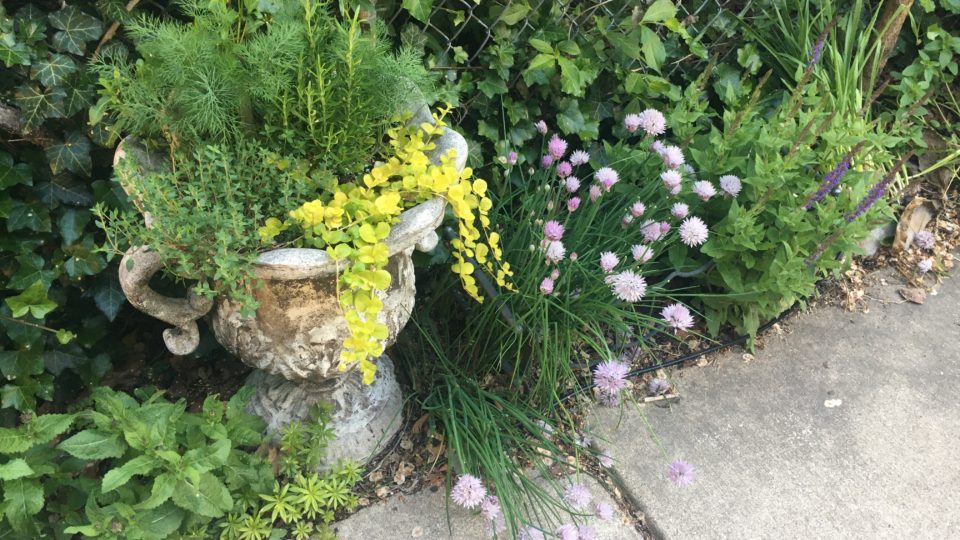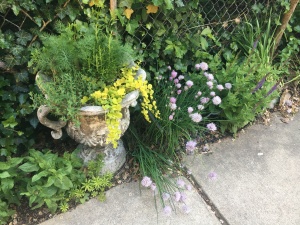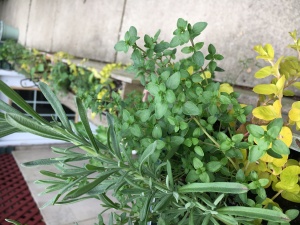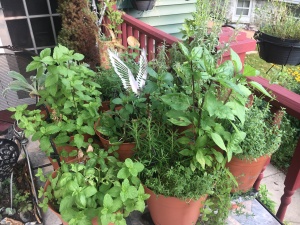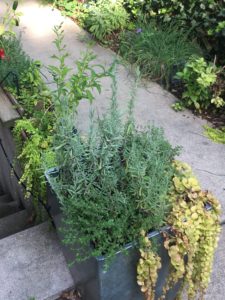by Tiffany Ordonez
Keeler Garden offers many types of plants in as much variety as you can think of. My name is Tiffany, I am an intern here at Keeler Gardens and today I’ll be telling you about our herb garden from this season and what we have for the community. Our herb garden supports perennial and annual herbs. Perennial herbs are herbs that last for more than one or two years, and annual herbs are herbs that complete their life cycle, from germination to the production of seeds, within one growing season. We also refer to herbs as annual when their natural growing area is so much warmer than they can’t survive over the winter. In their native space, they would be perennial, though here and in areas where it gets too cold, we consider them annual as they only last one growing season.
Our Established Perennial Herbs
Greek Oregano
The first herb I would like to talk about would be our Greek Oregano, whose botanical name is Organum prismaticum. Oregano is an aromatic perennial herb in the mint family (Lamiaceae) and is also has antibacterial benefits. Oregano was not widely used in the United States until after the Second World War. Soldiers discovered the herb and brought it home. Oregano is usually grown as a small evergreen subshrub, though here in Chicago it dies back in the winter. Greek oregano is a preferred culinary herb, and its leaves can offer more flavorful when dried. It is warm with a bit of sharpness.
Italian Oregano
Italian oregano typically reaches 12 to 18 inches high and spreads nearly as wide, covering the ground. If stems are left to grow longer, tiny pink flowers will emerge in late summer We sometimes let a portion flower for pollinators, but we try to harvest of culinary use before it flowers to get the best flavor. It’s one of the most versatile and delicious herbs for making sauces and soups.Italian oregano has slightly larger leaves than Greek oregano, making them easier to dry and store. It works here in Chicago because it is perennial in zones 5 through 10.
English Thyme
English thyme is a low-growing plant with richly fragrant leaves. This herb goes well with just about everything. Thyme leaves are small, but they hold an abundance of savory flavor. Savory herbs accent hardy meals, soups, and sharply-flavored sauces. It is native to the Mediterranean, with has dark gray-green leaves that leave a scent lingering on your fingers when you rub them. Pale pink flowers may be seen in summer, so you can use them decoratively and as a savory culinary herb.
Chives
Chives are native to the Balkans, an area that includes modern-day Turkey, Greece, Bulgaria, and parts of southwestern Russia. Chives are a perennial member of the onion family that sport beautiful edible flowers. Plus, they’re a wonderful companion plant that helps deter pests. Chives grow in clusters, with their blade-like leaves growing straight upward. The green leaves are hollow and come to a point. Chives can grow up to two feet tall in ideal conditions and can spread out up to 12 inches around. They have a mild onion flavor that doesn’t tend to leave a long aftertaste. Typically, Chives are added at the end of the cooking process because they lose flavor when heated.
Sage
Sage is an evergreen perennial subshrub with woolly, grayish leaves that adds a musky, earthy freshness to foods. Spikes of purple/blue flowers appear in mid-summer. Sage plants bloom in mid-summer and should be planted in the cool days of fall or spring. Sage usually becomes too woody after a few years to produce many aromatic leaves, so it needs to be replaced every 3-4 years. Some types of sage plants have medicinal properties as well or are grown purely for ornamental purposes.
French Tarragon
French tarragon plants grow up to 24 inches high and 12 inches wide in two years. The leaves are narrow, up to 2 inches long, and have a fresh green color. Leaves are dark green, narrow, and slightly twisted. The plant will occasionally produce small, greenish flowers that are sterile. The leaves have licorice or anise flavor. French Tarragon is used in vinegar, oils, marinades, and salads. Also known as estragon, is a species of perennial herb in the sunflower family. It is widespread in the wild across much of Eurasia and North America and is cultivated for culinary and medicinal purposes.
Mints
Mint is actually a type of plant (Mentha genus) that’s native to the eastern Mediterranean area. It’s bright green in color, produces a pleasing aroma, and is very easy to grow in your own garden. Mint is a perennial herb with very fragrant, toothed leaves and tiny purple, pink, or white flowers. There are many varieties of mint—all fragrant, whether shiny or fuzzy, smooth or wrinkled, bright green or variegated. The most famous mint would be peppermint mint. Fresh peppermint is a bit too strong to eat, which is why it’s processed into peppermint oil. This flavors your candy canes and tea, but can also be used medicinally and to scent oil diffusers.
Our Annual Herbs
Rosemary
The first annual herb we’ll be talking about would be the rosemary, a shrub with fragrant, evergreen, needle-like leaves and white, pink, purple, or blue flowers, native to the Mediterranean region. It is used as a culinary condiment, to make bodily perfumes, and for its potential health benefits. Rosemary is a member of the mint family Lamiaceae, along with many other herbs, such as oregano, thyme, basil, and lavender. The herb can be used with the needles removed and minced or as whole sprigs, to infuse flavor into a larger dish like a stew or roast.
German Thyme
German Thyme produces dainty, flavorful leaves that are excellent used for cooking or for tea. Harvest as needed and cut back to about 3″ (1cm) two or three times per season to encourage thicker growth. Easily dried for long-term storage. The plant is perennial in regions with mild winters. Thyme is an easy and practical herb to grow. Highly aromatic, it enhances meat dishes, eggs, cheeses, soups, and sauces. German thyme has smaller, slightly rounded leaves than the other varieties, but the foliage is packed with lots of flavors.
Lemon Thyme
Lemon thyme is a small, shrub-like herb with tiny leaves growing in clusters along multi-branched stems. Natural compounds in Lemon thyme, like limonene and thymol, give the herb a citrusy flavor. Lemon thyme is a tiny shrub that has leaves that remain very ornamental all year long. Its name comes from its taste, which reminisces of lemon. It is often used in infusions and to flavor sauces and soups. Native to the Mediterranean area, lemon thyme is very fragrant and is particularly well suited to seasoning grilled meat and fish. With luck we may see these two types of thyme return after the winter, they might just be hardy enough to grace us with their flavors again next year.
Flat Leaf Italian Parsley
Italian parsley (sometimes known as flat-leaf parsley) is a green herb with serrated leaves and a clean and peppery taste. It has a stronger flavor than curly parsley and is often used as a garnish. Italian parsley has leaves that are larger and a fresh, grassy smell. Italian parsley is available year-round and is easy to grow at home, and its flavor lends well to soups, sauces, stews, and adds a zesty flavor to salads. It also melds well with seafood, as well as grilled or roasted meats.
Curly Parsley
Parsley, or Curly parsley, is a commonly known herb, most often associated with being a garnish. Parsely is typically harvested as an annual. Not only is it used for its leaves and stems, but its roots also have medicinal properties. The herb is in the same family as celery, carrots, and cumin and the plant is native to the Mediterranean region. The leaves are nutritious and high in vitamins A, C, and E, as well as high in chlorophyll, making this herb a natural breath freshener.
Cilantro
Cilantro is an herb and a member of the Apiaceae family. It is commonly used in Latin American and Asian dishes and is sometimes referred to as “Mexican parsley” or “Chinese parsley”. Also is an annual herb that is part of the Apiaceae family of plants, which also includes carrots, fennel, parsley, celery, anise, and cumin. Cilantro is commonly used in Mexican inspired foods including, but not limited to salsa, bean dips, or guacamole, and used as a topping for chili, tacos, and enchiladas.
Anouk Lavender
Lavender is best grown in hot, sunny, and arid climates. The herb will be taller and wider in mild winter, hot summer climates. Anouk Lavender has dark purple flower heads topped with delicate mauve-lilac flags. Its fragrance makes it a perfect focal point in containers and perennial beds. Lavender is also pollinator-friendly, as deer and rabbits avoid it. Lavender flowers are greatly dried and used in tea, cooking, and perfumes.
We offer a sincere thank you to Bonnie Plants for their generous support of our 2021 herb gardens. We are so grateful for the opportunity to share this new program and look forward to it in future growing seasons.
